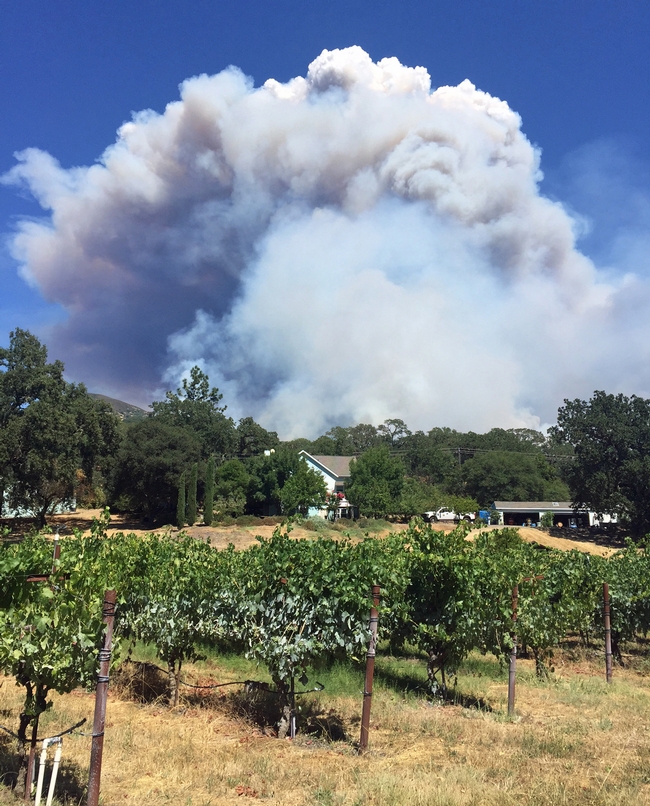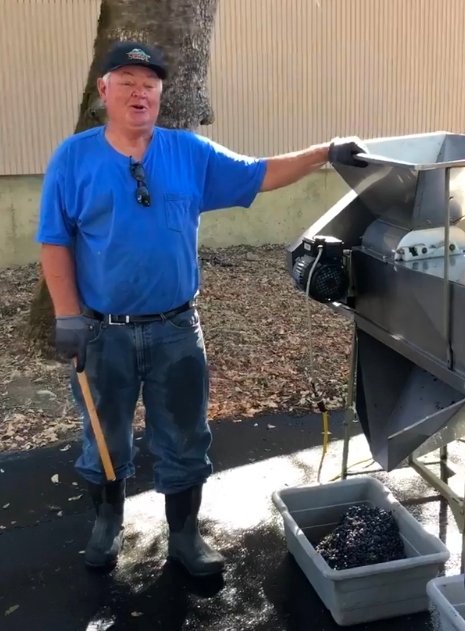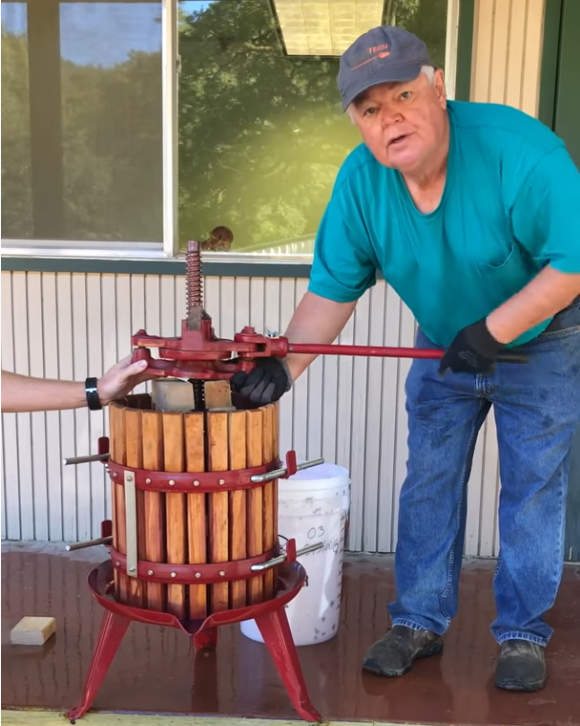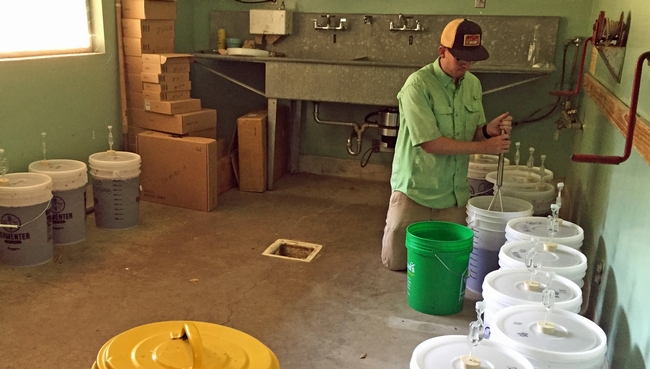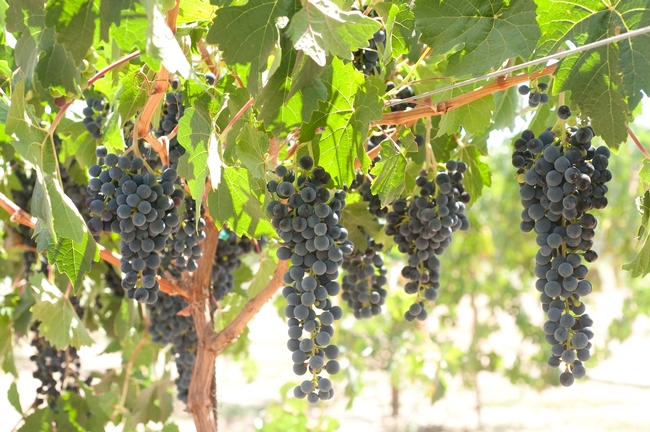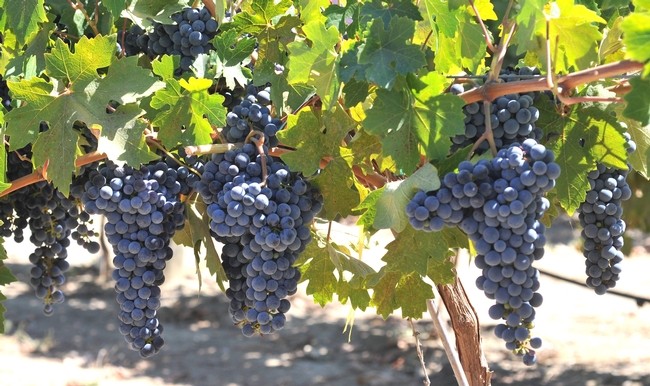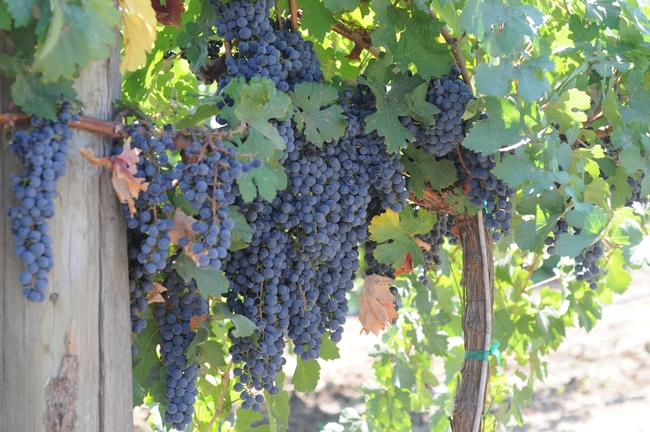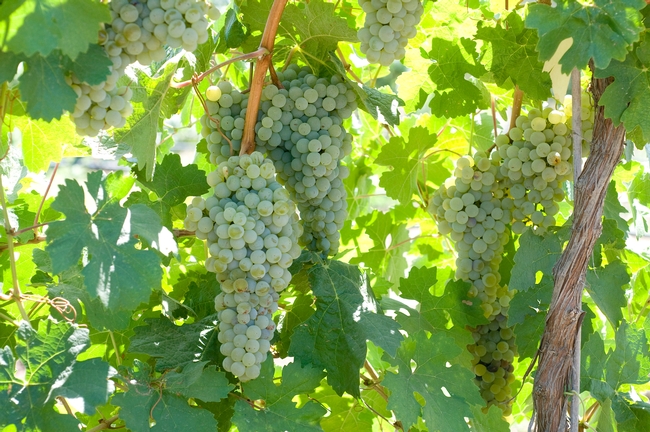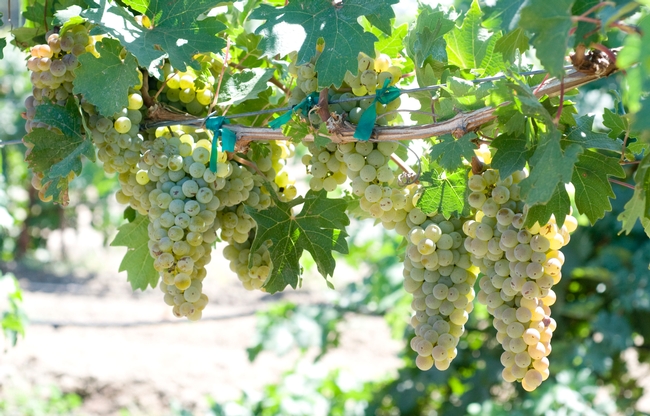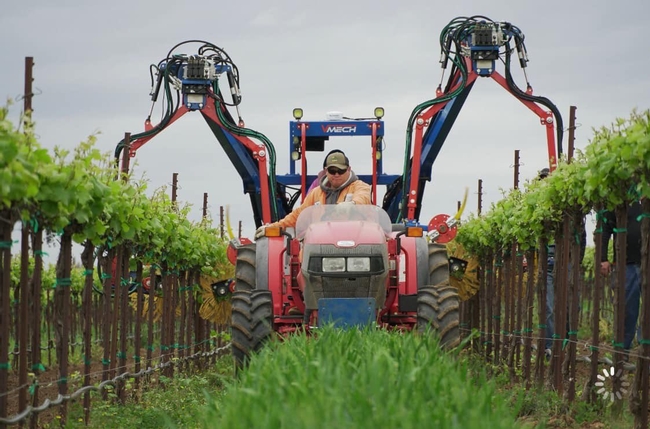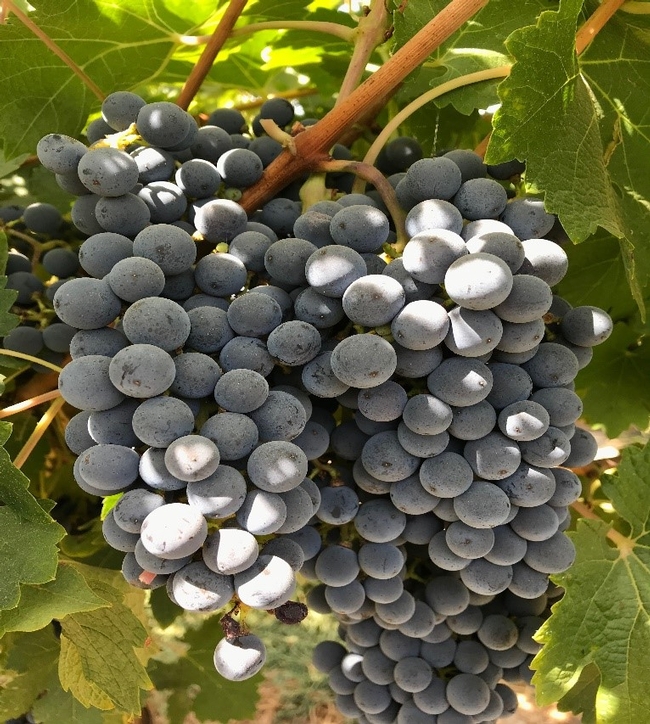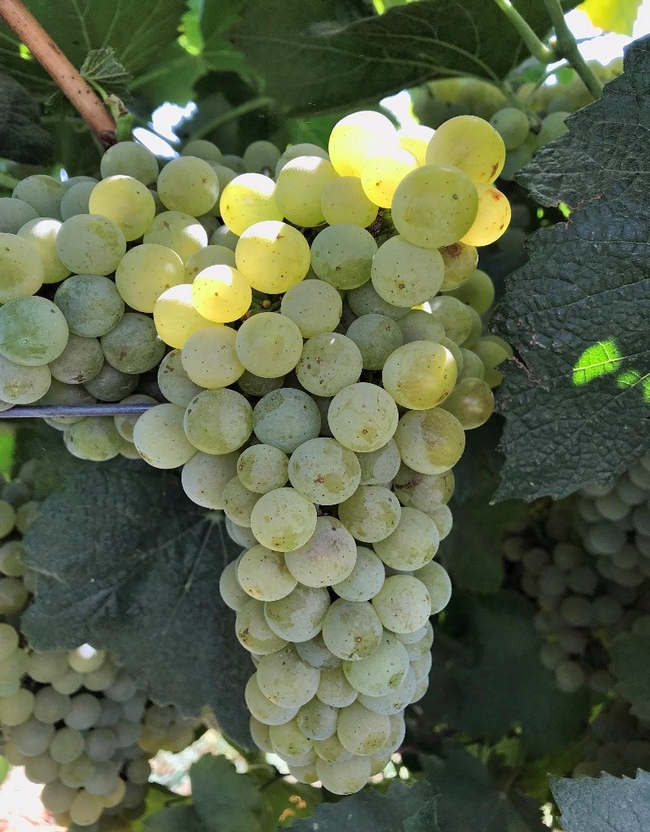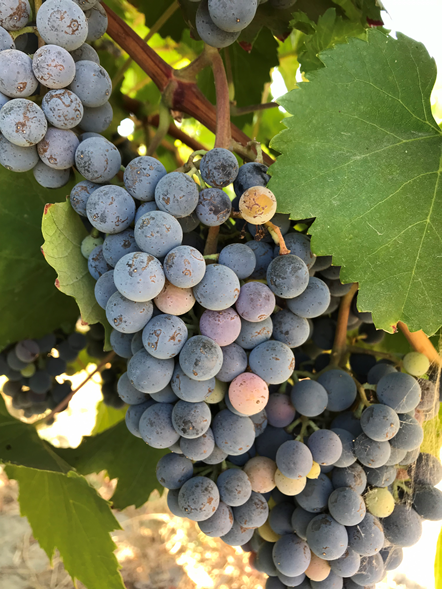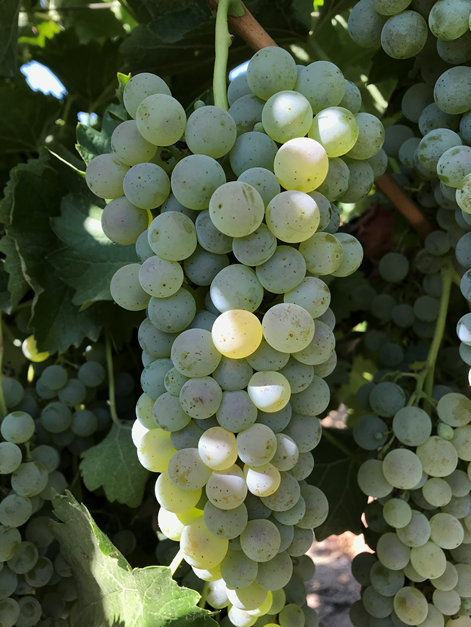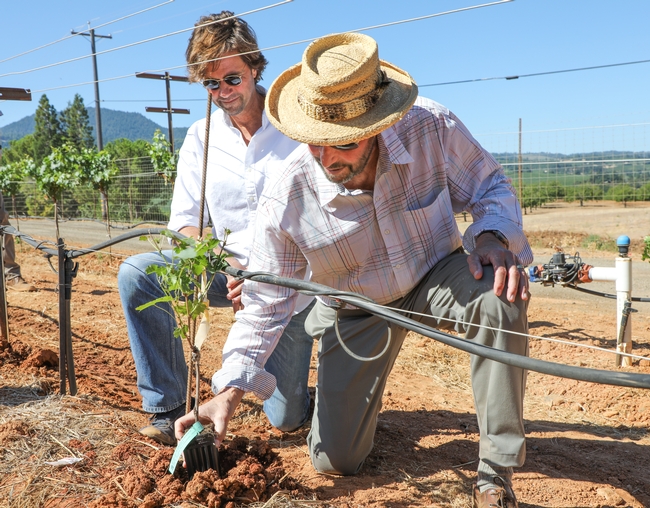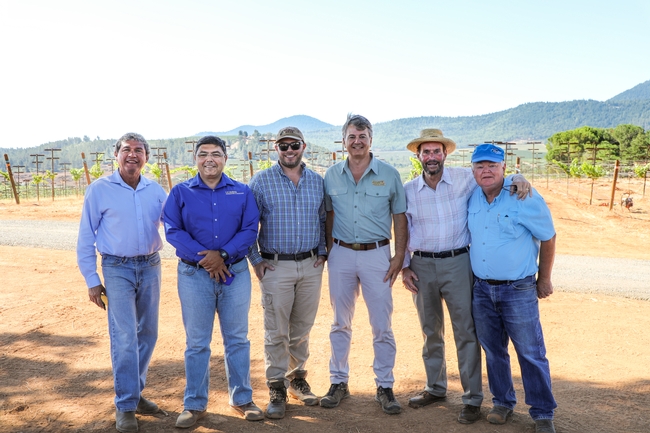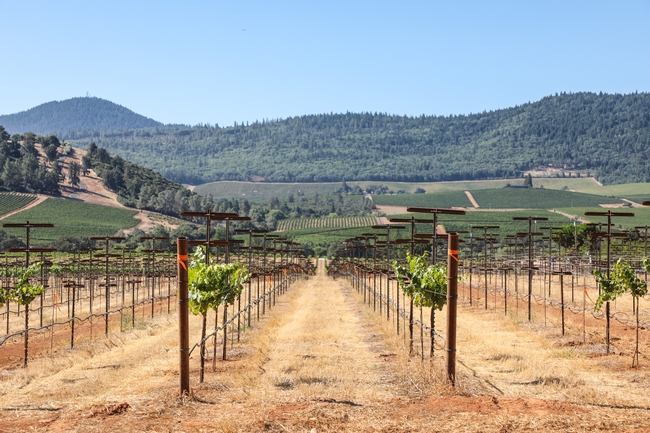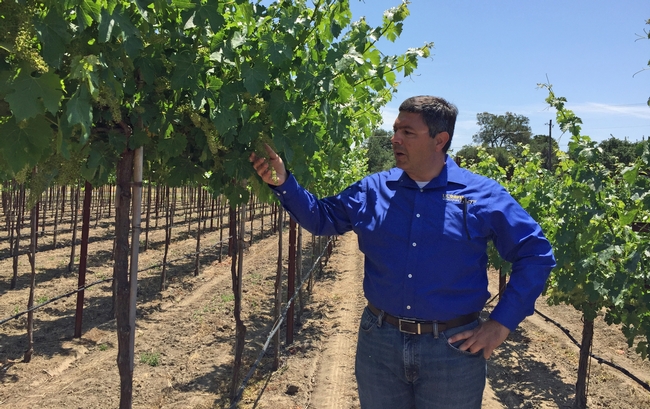Posts Tagged: winegrapes
Where there is fire, is there smoke flavor in winegrapes?
UPDATED: Viticultural area is Kelsey Bench, not Kelseyville Bench.
UC Cooperative Extension study shows smoke damage to grapes not uniform across vineyards
By the time the Mendocino Complex Fires were officially contained on Oct. 4, 2018, five weeks after igniting, they had burned approximately 450,000 acres in Colusa, Lake, Glenn and Mendocino counties, making it the largest wildfire in California history, according to CalFire.
The fire not only destroyed 280 homes and other buildings, its smoke destroyed the market for wine grapes grown in vineyards near burned areas.
Fearing grapes near the fire would impart smoke flavors to the wine, some wineries rejected all fruit from nearby regions of Lake County and Potter Valley, leaving grape growers to hastily find new destinations for their 2018 crop.
“It can be difficult to determine if fruit has been compromised in quality when exposed to wildfire smoke, and whether or not smoke flavors will result in wine when fermented,” said Glenn McGourty, UC Cooperative Extension advisor in Mendocino County.
A new UC Cooperative Extension study shows wind direction and speed, temperature and a vineyard's proximity to an active fire are factors that can help growers and winemakers predict smoke damage to fruit.
“Fruit in my own vineyard, 60 feet across the street from where the fire started, had no smoke damage because the wind was blowing away from it,” McGourty said.
$41 million hit to wine grape sales
Due to the Mendocino Complex Fires, an estimated $41 million worth of winegrapes, which would have been sold at full price, were impacted – some were sold at a discount, some were sold to other customers, some were custom crushed, while some were left hanging in the vineyard, according to the Lake County Winegrape Commission and Mendocino County Farm Bureau.
The wine industry needed a scientific method of determining whether grapes could be made into a wine untainted by smoke. With funding from the Lake County Winegrape Commission, McGourty formed a workgroup of local growers and winemakers with Anita Olberholster, UC Cooperative Extension enology specialist in the Department of Viticulture & Enology at UC Davis, to research when fruit quality has been compromised.
“The need for industry standards regarding the impact of wildland smoke on winegrapes and the resulting wines has become even more pressing over the past few years,” said Debra Sommerfield, president of the Lake County Winegrape Commission.
Science showed the intensity, duration and timing of the exposure to wildfire smoke affects the grape's uptake. Generally, the closer to harvest, the greater risk to the fruit.
“Both the fruit and wine samples in our study showed a wide range of volatile phenol and glycocide concentrations, indicating that smoke damage to fruit was not uniform across the vineyards sampled,” McGourty said.
Volatile phenols and glycosides create off-flavors
Fresh smoke contains volatile phenols and glycosides that can affect fruit, but these chemicals tend to dissipate in the atmosphere in 1 to 2 hours. Vineyards close to actively burning fires and in the path of fresh smoke are most likely to be affected by smoke taint. Smoke that travels long distances is less likely to affect grapes and the wine made from the fruit.
The combination of volatile phenols and glycosides create “smoke taint” – both aromatic and tactile in the mouth. Wine drinkers may smell smoke or other off flavors and experience a drying of their mouth when high concentrations of the chemicals are present in wine.
“At lower concentrations, smoke taint reminds you of brett-affected wines,” Oberholster explained, referring to the yeast brettanomyces. “There is a shortness of fruit, a kind of dryness in the mouth that you know isn't normal. There may be barely perceptible aromas that aren't normal as well.”
Following wildfire smoke exposure, the researchers sampled fruit from 14 cabernet sauvignon vineyards around the viticultural areas of Lake County, including Upper Lake, High Valley, Big Valley, Kelsey Bench, Red Hills, Lower Lake and Guenoc Valley. As a control, fruit was also sampled from a Napa Valley vineyard that was not exposed to wildfire smoke.
“The volatile phenols guaiacol and 4-methyl guaiacol are detected in the fruit by gas chromatography, so it is possible to sample fruit before harvest to make picking decisions,” McGourty said. “Based on our study, berry sampling and guaiacol/ 4-methyl guaiacol analysis are useful for a quick evaluation of whether or not fruit from a particular vineyard may have the presence of volatile phenols that can potentially result in smoke-affected wine.”
Testing the fruit for volatile phenols and glycosides is both expensive and not completely predictive as standards are not well defined for damage based on smoke chemical concentration, he cautioned.
These two compounds aren't the only ones that cause smoke flavors. More than 70 other compounds in forest fire smoke can also produce undesirable flavors and odors described as “like licking an ash tray, burnt garbage, a burnt potato, a campfire that has been drenched with water.”
The taste test
To assess the levels of the compounds that produce the off-flavors, Oberholster convened a panel of 14 wine industry professionals to taste the sample wines. The wine tasters detected stronger off-flavors in the wines made from riper fruit, which also contained higher concentration of smoke compounds. Less than 6 micrograms per liter of the smoke compounds were difficult for the tasters to detect, leading the researchers to conclude they will have a minimal effect on wine quality.
Smoke from a distant fire
The scientists also looked at the influence of distance from the fire and elevation on smoke taint. They found some vineyards close to the edge of fires and immediately downwind were heavily affected, with the grapes containing high concentrations of the smoke flavor-causing compounds. But they determined elevation was not a factor in smoke flavors in wines.
Wind direction and speed, temperature and vineyard proximity to active fires are highly likely affect whether there will be smoke damage to the fruit, their research showed.
“Smoke generated in the first one or two hours from a wildfire is most damaging to nearby vineyards,” McGourty said. “Even though a vineyard may be enveloped in smoke, if the source of the smoke is from a distant fire, it will probably won't seriously damage the fruit quality because most of the volatile gases are gone.”
Lake County Winegrape Commission's Sommerfield said, “Today, the results of this study are already proving to be useful in deepening our understanding of smoke and the risks it poses to grapes and wine, in enabling grape growers and winery buyers to engage in fruitful discussions and make informed decisions, and, in turn, in helping to propel the development of industry standards and protocols.”
To read more about the study by McGourty, Michael I. Jones, Oberholster and Ryan Keiffer, see the January 2020 edition of Wine Business Monthly at https://www.winebusiness.com/wbm.
“This is a great little study, the first one that I know of that takes a systems approach to evaluating the effects of wildfire smoke,” said McGourty.
Glenn McGourty, UCCE viticulture advisor for Mendocino County, describes for Hannah Bird the UC project to analyze the effect of wildfire smoke on winegrapes.
UC Davis releases 5 grape varieties resistant to Pierce’s disease
For the first time since the 1980s, University of California, Davis, researchers have released new varieties of wine grapes. The five new varieties, three red and two white, are highly resistant to Pierce's disease, which costs California grape growers more than $100 million a year. The new, traditionally bred varieties also produce high-quality fruit and wine.
“People that have tasted the wine made from these varieties are extremely excited,” said Andrew Walker, geneticist and professor of viticulture and enology at UC Davis, who developed the new Pierce's disease-resistant varieties. “They are impressed that they're resistant, but also that they make good wine.”
Pierce's disease a growing threat
Pierce's disease is caused by a bacterium spread by a group of insects called sharpshooters. It causes grapevine leaves to yellow or “scorch” and drop from the vine. The grape clusters also dehydrate, and infected vines soon die. While the disease has been around since the beginning of wine grape production in California, concerns have escalated with the arrival of the nonnative glassy-winged sharpshooter, which has the potential to spread the disease more rapidly. Pierce's disease occurs most often near rivers and creeks, and around urban and rural landscaping where sharpshooter populations reside.
Pierce's disease also threatens wine grapes in the southeastern U.S. Rising temperatures from climate change could increase the spread of the disease, which is thought to be limited by cold winters. Growers in the Southeast can usually only grow Pierce's disease resistant varieties that don't have the same wine quality as the European winegrape species, Vitis vinifera, which is typically grown in California.
New varieties more sustainable
To create the new varieties, Walker crossed a grapevine species from the southwestern U.S. and northern Mexico, Vitis arizonica, which carries a single dominant gene for resistance to Pierce's disease and was used to cross back to Vitis vinifera over four to five generations. It's taken about 20 years to develop the five patent-pending selections that are now being released.
“These varieties will hopefully make viticulture much more sustainable and provide a high-quality wine that the industry will welcome,” said Walker. “So far there has not been tremendous interest in new wine grape varieties, but climate change may encourage growers to reconsider wine grape breeding as we work to address future climates and diseases.”
Winemaker Adam Tolmach, owner of The Ojai Vineyard in Ojai, planted four of the new varieties as part of a 1.2-acre experimental field trial. The trial was on the same plot of land where Pierce's disease wiped out his grapes in 1995. The vineyard then and now is organic, so spraying insecticides to fight the disease spread wasn't an option.
“I wasn't interested in planting in that plot again until I heard about these new Pierce's disease-resistant grape varietals,” said Tolmach. “This year was the first harvest. We've just begun to evaluate the wine but I'm very encouraged.”
Five varieties to suit every taste
The five new varieties of wines were evaluated by sensory tasting panels. Tasters included leading industry winemakers and enologists in prominent wine-growing regions of California and Texas as well as regions in the southeastern U.S.
“What I think is exciting is that they're stand-alone varieties independent of whether they have Pierce's disease resistance,” said Doug Fletcher, former vice president of winemaking for Terlato Family Wine Group.
The three new red varieties are camminare noir, paseante noir and errante noir.
Camminare noir has characteristics of both cabernet sauvignon and petite sirah. The selection has ranked highly at numerous tastings of fruit grown in both Napa and Davis. Tasting comments: dark-red purple color, bright red fruit, raspberry, cherry, ripe, tannic, elegant rather than dense. The variety is 50% petite sirah and 25% cabernet sauvignon.
Paseante noir is similar to zinfandel. It has also been ranked highly at tastings. Tasting comments: medium dark red with purple; berry pie, cassis, black olive, herbal, dried hay, coffee, vegetal like cabernet sauvignon, licorice, round, moderate tannins, soft finish. The variety is 50% zinfandel, 25% petite sirah and 12.5% cabernet sauvignon.
Errante noir is a red winegrape most similar to a cabernet sauvignon and has great blending potential. Tasting comments: dark-red purple color; complex fruit with herbs and earth, plum, big wine, dense, rich middle, tannic yet balanced. The variety is 50% sylvaner and 12.5% each of cabernet sauvignon, carignane and chardonnay.
The two new white grape varieties are ambulo blanc and caminante blanc.
Ambulo blanc is similar to sauvignon blanc and has been tested in Temecula, Sonoma and along the Napa River. Tasting comments: light straw to clear color, citrus, lime, tropical, gooseberry, golden delicious apple flavors; bright fruit, slightly bitter, textured. The variety is 62.5% cabernet sauvignon, 12.5% carignane and 12.5% chardonnay.
Caminante blanc has characteristics of sauvignon blanc and chardonnay. Wines have been made from Davis fruit and ranked well. Field trials are underway at Pierce's disease hot spots in Ojai and Napa. Tasting comments: light straw-gold color, apple-melon, lychee, floral aromas, pineapple, green apple, juicy, harmonious, well-balanced. The variety is 62.5% cabernet sauvignon, 12.5% chardonnay and 12.5% carignane.
These five varieties are ready for patenting and release. There will be limited amounts of plant material available for propagation in 2020 as only a few of the grape nurseries participated in a pre-release multiplication program. Much more will be available in 2021. The Pierce's disease resistance breeding program continues, and more selections are approaching release.
UC releases new cost studies for mechanized winegrape production
New studies provide details about trellis type, planting density, cost and potential benefit of vineyard mechanization
UC Agriculture and Natural Resources' Agricultural Issues Center has released four new studies detailing the costs and returns of wine grape production in the southern San Joaquin Valley. All four cost studies illustrate the cost and benefit of nearly full mechanization on wine grape production.
The studies estimate the cost of establishing a vineyard and producing wine grapes, focusing on four wine grape varieties – Cabernet Sauvignon, Chardonnay, Rubired and Colombard.
“Those studies take into consideration mechanical pruning, leafing, shoot thinning, and harvest on a typical wine grape vineyard with the average production level for this region,” said George Zhuang, UC Cooperative Extension viticulture advisor in Fresno County.
“With farming labor becoming more scarce and expensive, growers will opt to transition into more mechanization,” Zhuang said. “These studies provide detailed information about the trellis type, planting density, cost and potential benefit of vineyard mechanization. Based on these studies, fully implemented mechanization reduces the production cost from $3,000 to $2,500 per acre and that represents 17% cost reduction. This information will ultimately help growers to guide their production practices to more profitable and competitive ways under the new era of farming labor.”
Wine grape growers should look at the costs, particularly expenses associated with mechanization, Zhuang said.
“The investment to purchase and own equipment can be high,” Zhuang said. “Fortunately, it is easy to find a contractor in this region to perform certain vineyard tasks, if the initial investment to purchase equipment is prohibitive.”
Numerous studies, including UC studies, have confirmed the benefits of vineyard mechanization to grape and wine quality with lower production costs.
“It is a win-win-win situation,” Zhuang said. “Growers can improve their farming margins, wineries and juice processing plants can get reliable and higher quality grapes and juice from farms, and average consumers can enjoy better wine and more healthy grape products at an affordable price.”
The studies are based on 200-acre farms with the vineyard established on 40 acres using two types of trellis systems – quadrilateral cordon system and bilateral cordon system. In addition to regular grape production expenses – such as irrigation, fertilization and pest control – the researchers broke out the differences between machinery costs and hand labor hours required for thinning, pruning and harvesting for each variety.The prices for labor, materials, equipment and custom services are based on October 2019 figures.
The California minimum wage law will gradually decrease the number of hours employees can work on a daily and weekly basis before overtime wages are required. For more information and to view the California minimum wage and overtime phase-in schedules visit aic.ucdavis.edu.
Input and reviews were provided by UC Cooperative Extension farm advisors, specialists, grower cooperators and other agricultural associates. The authors describe the assumptions used to identify current costs for wine grape establishment and production, material inputs, cash and non-cash overhead. A ranging analysis table shows profits over a range of prices and yields.
The new studies are:
- 2019 - Sample Costs to Establish and Produce Winegrapes in the Southern San Joaquin Valley – Chardonnay Variety
- 2019 - Sample Costs to Establish and Produce Winegrapes in the Southern San Joaquin Valley –Cabernet Sauvignon Variety
- 2019 - Sample Costs to Establish and Produce Winegrapes in the Southern San Joaquin Valley – Rubired Variety
- 2019 - Sample Costs to Establish and Produce Winegrapes in the Southern San Joaquin Valley – Colombard Variety
All four winegrape studies can be downloaded from the UC Davis Department of Agricultural and Resource Economics website at http://coststudies.ucdavis.edu. Sample cost of production studies for many other commodities are also available on the website.
For additional information or an explanation of the calculations used in the studies, contact Donald Stewart at the Agricultural Issues Center at (530) 752-4651 or destewart@ucdavis.edu.
For information about local grape production, contact George Zhuang, UCCE viticulture advisor for Fresno County, at gzhuang@ucanr.edu; UCCE viticulture specialist Matt Fidelibus at mwfidelibus@ucanr.edu; UCCE viticulture specialist Kaan Kurtural at skkurtural@ucdavis.edu; Karl Lund, UCCE viticulture advisor for Madera, Merced and Mariposa counties, at ktlund@ucanr.edu; or Gabriel Torres, UCCE viticulture advisor for Kings and Tulare counties, at gabtorres@ucanr.edu.
To save cabernet from climate change, UC studies rootstock and clone combinations
UC Cooperative Extension, Beckstoffer Vineyards and Duarte Nursery are launching the wine industry's most ambitious cabernet sauvignon rootstock and clone trial in the Red Hills of Lake County to give the varietal greater resilience to climate change.
Cabernet sauvignon is California's second top-selling varietal by volume, just behind chardonnay.
“We have been growing cabernet sauvignon since the 1970s, and we are very proud to be part of this trial, which will help improve cabernet sauvignon growing for years to come,” said Andy Beckstoffer, owner and CEO of Beckstoffer Vineyards, which is providing the land and labor for the project.
The industry-driven trial – “Climate-smart Solutions for Cabernet Sauvignon Production” – includes 3,600 vines with 10 cabernet sauvignon clones on 10 rootstocks.
“This trial will give us data that will help inform and improve growing practices for cabernet sauvignon across the state for the next two decades,” said the trial's lead researcher, S. Kaan Kurtural, UC Cooperative Extension viticulture specialist at UC Davis Department of Viticulture and Enology and Oakville Experiment Station.
While the experimental vineyard is in Lake County at a property known as Amber Knolls, the data will be analyzed in Oakville.
The trial officially launched Aug. 15 in Kelseyville with a celebratory vine planting as Andy Beckstoffer and son David Beckstoffer planted the vine that also marked a milestone – the 1.5 millionth vine for Beckstoffer Vineyards Red Hills. Researchers, industry representatives and journalists gathered to celebrate what is affectionately known as “the mother of all cabernet trials.”
“Everything is wonderful in Lake County – for growing cabernet sauvignon and for doing research,” Andy Beckstoffer said, noting the Lake County region's ongoing support for farming.
Pedro Rubio, Beckstoffer Vineyards Red Hills general manager, said, “Lake County will definitely benefit, but the results from this trial will be very helpful for the whole industry.”
Designed to address resiliency in a changing climate, the trial will examine which combinations give the best results with a focus on drought tolerance and water-use efficiency as well as crop yield and grape quality.
“The idea behind the trial is to gain further insights into the interactive effects of rootstock selections crossed with cabernet clones and the impact of that on water relations and overall sustainability,” said Clint Nelson, ranch manager for Beckstoffer Vineyards Red Hills.
“The trial will give us an understanding of the synergistic relationship of clone and rootstock and what combination drives the best quality and production,” he said.
According to Nelson, the trial will look at canopy architecture, yield components, water relations, traditional fruit chemistries, secondary metabolites such as aroma, mouthfeel and color, as well as overall vine performance.
Duarte Nursery is providing all of the planting material for the trial.
“The diversity of rootstocks and clones chosen for this project includes some of the most modern cabernet sauvignon clones designed for high quality and for production,” said John Duarte, nursery president.
Duarte said the trial is employing a lot of cutting-edge technology and using some of the cleanest plant materials available to prevent grapevine viruses.
“Planting a vineyard with pristine nursery stock initially really extends the life of that vineyard,” Duarte said.
Viticulture has become more data-driven, and this trial will measure a staggering amount of data generated by the 100 or so rootstock-clone combinations over the approximately eight to 10 years of the trial's duration.
“Nothing of this scope has been attempted,” said UC Cooperative Extension specialist Kurtural, who acknowledged logistics as the biggest challenge with planning, data collection and timely analysis being at the forefront of his mind. “It keeps me up at night.”
Planning for the length of the project also is a concern. The vineyard will be planted this year and the first crop will be harvested in 2021. It will take at least six years to begin to see consistent results.
Kurtural said the project will provide research opportunities in academic and applied science for at least two students to complete work toward a doctoral degree in horticulture and agronomy.
Glenn McGourty, UC Cooperative Extension viticulture advisor for Lake and Mendocino counties, is a research collaborator on the project.
“Lake County obviously has an important role to play in fine wine in the North Coast, particularly for cabernet sauvignon,” McGourty said. “And this trial really marks the importance of this location in terms of the commitment and the collaboration that we see here among both public and private sectors.”
About Beckstoffer Vineyards: Named “Napa's most powerful grape grower” by both the Wall Street Journal and Wine Spectator, Beckstoffer Vineyards was founded in 1970. Beckstoffer Vineyards is firmly rooted in the soil of Northern California's wine country, with Andy Beckstoffer playing an integral role in the evolution of the wine grape industry since 1970. Joined at the family-owned business by his son David in 1997, they share a common mission – to produce the highest quality grapes in Northern California that form the foundation for exceptional wines – and a combined passion for the land and viticulture expertise. Beckstoffer Vineyards first acquired land in the Red Hills in 1997, which after subsequent acquisitions, today totals nearly 2,000 planted acres across three blocks: Amber Knolls Vineyard, Crimson Ridge Vineyard, and Amber Mountain Vineyard.
About Duarte Nursery: Duarte Nursery, Inc. (DNI) is a family-owned and operated nursery and the largest permanent crops nursery in the United States.
The winegrape industry is well suited to mechanized production
A major expense in producing winegrapes is labor. Two UC Cooperative Extension experts appeared on the Jefferson Exchange radio program to explain how mechanization of pruning, leaf removal and shoot thinning, combined with mechanized harvesting widely implemented decades ago, will dramatically reduce the need for labor in California winegrape production.
"The minimum wage is going to increase to $15 per hour in 2022," said George Zhuang, viticulture advisor with UCCE Fresno County. Besides, it is getting more challenging for growers to find enough workers due to labor shortages and higher wages in other fields, such as construction.
The machinery for mechanized vineyards requires an investment of about $100,000, said Kaan Kurtural, UCCE viticulture specialist. At that cost, growers begin to break even after a year.
The biggest obstacle to mechanization is the way winegrape vineyards have traditionally been trellised. The cross arms get in the way of machines as they go through the vineyards. In a recent research project by Zhuang and Kurtural, the scientists converted a traditional system to single high wire and managed it with mechanical equipment.
"It was more profitable ... with the same, if not better, quality and value at the farm gate," Kurtural said. "The writing is on the wall for growers to adapt to this as quickly as possible."
Host Geoffrey Riley asked whether the labor savings will result in cheaper wine. Kurtural laughed.
"No," he said. "Wine prices are set by market demand. I don't think wine is an expensive beverage."

